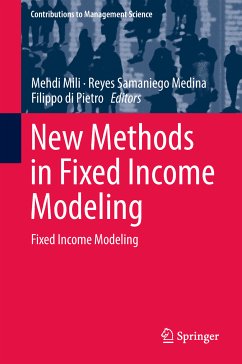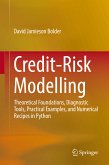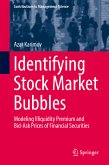New Methods in Fixed Income Modeling (eBook, PDF)
Fixed Income Modeling
Redaktion: Mili, Mehdi; Di Pietro, Filippo; Samaniego Medina, Reyes
72,95 €
72,95 €
inkl. MwSt.
Sofort per Download lieferbar

36 °P sammeln
72,95 €
Als Download kaufen

72,95 €
inkl. MwSt.
Sofort per Download lieferbar

36 °P sammeln
Jetzt verschenken
Alle Infos zum eBook verschenken
72,95 €
inkl. MwSt.
Sofort per Download lieferbar
Alle Infos zum eBook verschenken

36 °P sammeln
New Methods in Fixed Income Modeling (eBook, PDF)
Fixed Income Modeling
Redaktion: Mili, Mehdi; Di Pietro, Filippo; Samaniego Medina, Reyes
- Format: PDF
- Merkliste
- Auf die Merkliste
- Bewerten Bewerten
- Teilen
- Produkt teilen
- Produkterinnerung
- Produkterinnerung

Bitte loggen Sie sich zunächst in Ihr Kundenkonto ein oder registrieren Sie sich bei
bücher.de, um das eBook-Abo tolino select nutzen zu können.
Hier können Sie sich einloggen
Hier können Sie sich einloggen
Sie sind bereits eingeloggt. Klicken Sie auf 2. tolino select Abo, um fortzufahren.

Bitte loggen Sie sich zunächst in Ihr Kundenkonto ein oder registrieren Sie sich bei bücher.de, um das eBook-Abo tolino select nutzen zu können.
Applies new mathematical findings in finance to fixed income products and offers empirical examples of various market instruments
Focuses on fixed income investments that have created new market risks
Presents new trends in hedging fixed income instruments
- Geräte: PC
- ohne Kopierschutz
- eBook Hilfe
- Größe: 6.74MB
Andere Kunden interessierten sich auch für
![Credit-Risk Modelling (eBook, PDF) Credit-Risk Modelling (eBook, PDF)]() David Jamieson BolderCredit-Risk Modelling (eBook, PDF)52,95 €
David Jamieson BolderCredit-Risk Modelling (eBook, PDF)52,95 €![Risk Measurement (eBook, PDF) Risk Measurement (eBook, PDF)]() Dominique GuéganRisk Measurement (eBook, PDF)68,95 €
Dominique GuéganRisk Measurement (eBook, PDF)68,95 €![Identifying Stock Market Bubbles (eBook, PDF) Identifying Stock Market Bubbles (eBook, PDF)]() Azar KarimovIdentifying Stock Market Bubbles (eBook, PDF)80,95 €
Azar KarimovIdentifying Stock Market Bubbles (eBook, PDF)80,95 €![Risk Management in Banks and Insurance Companies (eBook, PDF) Risk Management in Banks and Insurance Companies (eBook, PDF)]() Anja BlatterRisk Management in Banks and Insurance Companies (eBook, PDF)80,95 €
Anja BlatterRisk Management in Banks and Insurance Companies (eBook, PDF)80,95 €![The Fear Factor (eBook, PDF) The Fear Factor (eBook, PDF)]() C. ReadThe Fear Factor (eBook, PDF)40,95 €
C. ReadThe Fear Factor (eBook, PDF)40,95 €![Empirical Asset Pricing Models (eBook, PDF) Empirical Asset Pricing Models (eBook, PDF)]() Jau-Lian JengEmpirical Asset Pricing Models (eBook, PDF)72,95 €
Jau-Lian JengEmpirical Asset Pricing Models (eBook, PDF)72,95 €![An Insight into Mergers and Acquisitions (eBook, PDF) An Insight into Mergers and Acquisitions (eBook, PDF)]() Vinod KumarAn Insight into Mergers and Acquisitions (eBook, PDF)88,95 €
Vinod KumarAn Insight into Mergers and Acquisitions (eBook, PDF)88,95 €-
-
-
Applies new mathematical findings in finance to fixed income products and offers empirical examples of various market instruments
Focuses on fixed income investments that have created new market risks
Presents new trends in hedging fixed income instruments
Focuses on fixed income investments that have created new market risks
Presents new trends in hedging fixed income instruments
Dieser Download kann aus rechtlichen Gründen nur mit Rechnungsadresse in A, B, BG, CY, CZ, D, DK, EW, E, FIN, F, GR, HR, H, IRL, I, LT, L, LR, M, NL, PL, P, R, S, SLO, SK ausgeliefert werden.
Produktdetails
- Produktdetails
- Verlag: Springer International Publishing
- Seitenzahl: 297
- Erscheinungstermin: 18. August 2018
- Englisch
- ISBN-13: 9783319952857
- Artikelnr.: 53615306
- Verlag: Springer International Publishing
- Seitenzahl: 297
- Erscheinungstermin: 18. August 2018
- Englisch
- ISBN-13: 9783319952857
- Artikelnr.: 53615306
- Herstellerkennzeichnung Die Herstellerinformationen sind derzeit nicht verfügbar.
Mehdi Mili, PhD, is an Associate Professor at the University of Bahrain, Kingdom of Bahrain. Previously he was Head of the Research Department at the Central Bank of Tunisia. He received his Master in Finance from the University of Sfax, Tunisia, in 2002, and his PhD in Finance from the University of Sfax, Tunisia and the University of Poitiers, France, in 2008. His research interests include fixed income modeling, interest rate risk management, and structured products. Mehdi is a regular conference speaker and his research has been published in several international journals (e.g. Emerging Markets Review, Economic Modeling, Journal of Asset Management) and funded by the University of Sfax and the University of Bahrain. Filippo Di Pietro, PhD, is an Associate Professor of Finance at the Department of Financial Economics and Operations Management, Universidad de Sevilla (Spain) and a contract agent at the Joint Research Center (European Commission). He teaches on financial derivatives markets and financial systems and markets at the undergraduate and graduate level. He received his Master's degree in Finance from the University of Bologna (Italy), and his doctorate in Business Administration, with a specialization in Finance, from the Universidad de Sevilla. He has been a Visiting Professor at various European universities, and his current research interests include corporate finance, SMEs, risk management, innovation, and regional financial systems. His recent contributions have been published in Long Range Planning, the Journal of Financial Service Research, Journal of Small Business Economics, Regional Studies, Applied Economics Letters, Sustainability, and the Journal of Economics and Business. Reyes Samaniego Medina, PhD, is a Senior Lecturer in Finance at the Pablo de Olavide University of Seville (Spain). She is currently a member of the Banking and Entrepreneurial Finance Research Group (https://www.upo.es/investiga/banef/) andhas been a visiting lecturer at e.g. the Centre of Quantitative Finance in London and the Leonard N. Stern School of Business in New York. She has published research articles in various journals, including the Journal of Banking and Finance, Journal of Business Economics and Management, and Journal of Economics and Business. Her main research interests are in the management and control of credit risk, the Basel Accords and capital structure.
Term Structure, Market Expectations of the Short Rate, and Expected Inflation.- A New Approach to CIR Short Term Rates Modelling.- The Heath-Jarrow-Morton Model with Regime Shifts and Jumps Priced.- Explicit computation of the post-crisis spot LIBOR in a jump-diffusion framework.- An Overview of Post-Crisis Term Structure Models.- A comparison of estimation techniques for the covariance matrix in a fixed-income framework.- The term structure under non-linearity assumptions: New methods in time series.- Affine type analysis for BESQ and CIR processes with applications to Mathematical Finance.
Term Structure, Market Expectations of the Short Rate, and Expected Inflation.- A New Approach to CIR Short Term Rates Modelling.- The Heath-Jarrow-Morton Model with Regime Shifts and Jumps Priced.- Explicit computation of the post-crisis spot LIBOR in a jump-diffusion framework.- An Overview of Post-Crisis Term Structure Models.- A comparison of estimation techniques for the covariance matrix in a fixed-income framework.- The term structure under non-linearity assumptions: New methods in time series.- Affine type analysis for BESQ and CIR processes with applications to Mathematical Finance.







